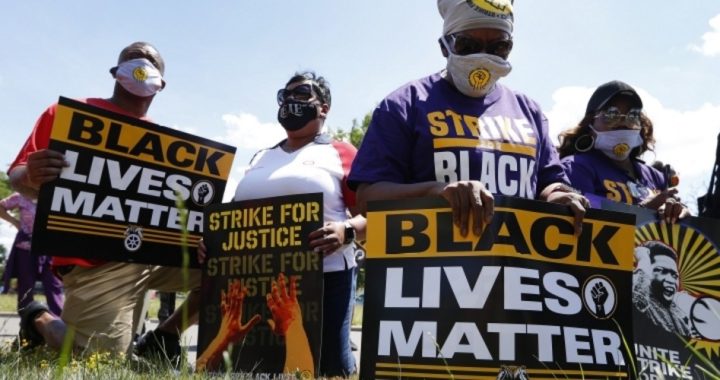
Labor unions recognized a prime opportunity to use the Black Lives Matter movement to increase their reach and push their agenda by teaming with a coalition of BLM groups to organize the July 20 Strike for Black Lives. On Monday, tens of thousands of workers nationwide walked off their jobs, purportedly as a show of solidarity with the Black Lives Matter movement, even while the strikers’ demands included a laundry list of union agenda items.
At noon in every time zone in the United States on Monday, Strike for Black Lives called upon workers to walk off their jobs in protest either for the remainder of the day, or for eight minutes and forty-six seconds — the amount of time white Minneapolis Police Officer Derek Chauvin held his knee on the neck of George Floyd in the final moments of his life. Those who were unable to walk out were asked to either take a knee at their posts or observe a moment of silence for the same length of time. Organizers estimate demonstrations took place in roughly 200 cities across the country with approximately 20,000 people participating.
“What the protesters are saying, that if we want to be concerned — and we should be — about police violence and people getting killed by the police … we have to also be concerned about the people who are dying and being put into lethal situations through economic exploitation all over the country,” said the Reverend William Barber II, co-chairman of the Poor People’s Campaign, one of the organizations behind the strike.
According to the strike’s website, the purpose of the walkout was for workers to “unequivocally” declare that “black lives matter” and to call upon business and political leaders to “reimagine our economy and democracy” with civil rights at the forefront.
“The Strike for Black Lives is a moment of reckoning for corporations that have long ignored the concerns of their Black workforce and denied them better working conditions, living wages and healthcare,” said Ash-Lee Henderson, an organizer with the Movement for Black Lives, a coalition of organizations that comprise the Black Lives Matter movement.
“We are … building a country where Black lives matter in every aspect of society — including in the workplace,” she added.
Fox News reports strikers also included essential workers such as nursing home employees, janitors, ride-share workers, etc.
But behind the protests were big labor unions, including the Service Employees International Union, International Brotherhood of Teamsters, American Federation of Teachers, and dozens of other labor and political groups. The LA Times reported the event’s participants were “mainly members of groups applied with the SEIU.”
Kent Wong, director of the UCLA Labor Center, which helps organize immigrant workers in Los Angeles, contends Monday’s protests underscore the beginning of a “more comprehensive movement-building strategy that aligns worker justice and racial justice.”
Union leaders are hoping to capitalize on the racial unrest in the United States to advocate for an anticapitalistic, pro-union economy.
“A global health pandemic, an economic depression, and continued structural and systemic racism have converged in a perfect storm, and the lives of working class people of color have never been more at risk,” Transit Union President John Costa said in a statement in support of the protests. “Now is not the time to be observers on the sidelines. Now is the time to rise up together to inaugurate a new day of racial and economic justice for all.”
Among the list of demands on the strike’s website were calls for businesses and lawmakers to “dismantle racism, white supremacy, and economic exploitation,” allow workers access to union organizing, and rewrite laws to create an economy and democracy in which “Black communities can thrive.” The demands also called for increased COVID-19 protections and enhanced support during the public-health crisis, including guaranteed sick pay, affordable healthcare coverage, and better safety measures.
Many protesters also used the opportunity to demand higher wages and better coronavirus protections from their employers. AT&T employees in Memphis, for example, demanded the company use its resources to enhance coronavirus protections for black employees. In St. Louis, McDonald’s employees called for higher wages.
In New York City, more than 150 union workers gathered outside Trump International Hotel to demand that the U.S. Senate and President Trump adopt the HEROES Act, which provides extended unemployment, essential pay, and protective equipment to employees who are unable to work from home, U.S. News & World Report observed.
The LA Times notes Monday’s protests avoided some of the more “thorny issues involving race in the labor movement,” including the role of police unions in defending “rogue” police officers and “apprentice systems that tend to favor white workers.”
But despite the pro-union agenda of the strike, some companies encouraged employees to participate in the demonstration, Fox News reports. Airbnb issued a statement wherein the company said it had provided suggestions to its employees on how to participate in the strike and even authorized workers to take paid time off to strike.
“At Airbnb, we believe in empowering our employees to be activists and allies,” the company posted on its site. “It’s important that we give our employees the opportunity, if they choose, to peacefully express themselves — and we support their right to do so. During this unique time, employees may take time off with manager approval to participate in peaceful protests without reducing their regular weekly pay.”
The strike had some international support. In South Korea, workers with a transport workers union passed a resolution to support the strike. McDonald’s workers in São Paolo, Brazil, rallied outside their restaurant.
Photo: AP Images
Raven Clabough acquired her bachelor’s and master’s degrees in English at the University of Albany in upstate New York. She currently lives in Pennsylvania and has been a writer for The New American since 2010.




